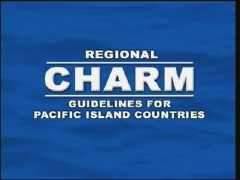Tiempo Climate Cyberlibrary
CHARM
Currently, risk management activities in the Pacific
tend to be limited to single government departments or
regional organisations. In many instances, national risk
reduction efforts are uncoordinated and in such cases
duplication of efforts is common and planning gaps
exist.
In order to address this situation, the South Pacific
Applied Geosciences Commission (SOPAC) member countries
have committed themselves to a more integrated
Comprehensive Hazard And Risk Management - CHARM -
process.
CHARM covers all hazards and is whole of country in
orientation. It will enhance the sustainability of national
development planning processes and encourage a more
coordinated and integrated regional approach to risk
reduction.
CHARM is modelled around the AS/NZS
4360-1999 Standard. It uses the Queensland design
format, modified to suit Pacific region requirements.
CHARM moves the focus away from departments and agencies
that support a wide range of non-coordinated activities
towards a broader and integrated programming approach. This
is achieved by aligning the CHARM process with National
Strategic Development Plans.
The major goal of the CHARM model is to develop a
national risk and treatment option matrix that has
considered the activities of all agencies. CHARM targets
the identified gaps in the matrix.
There are five main steps in the CHARM process.
- Establish the context
- Sensitize senior political and policy
officials
- Identify strategic an organizational issues that
will apply to the CHARM process
- Determine the CHARM management mechanisms and
operational process
- Identify national development priorities
- Review existing policy related to development
project appraisal processes
- Implement training to mainstream mitigation into
this process
- Develop the initial risk evaluation criteria
- Identify risks
- Identify and assess primary and secondary
hazards
- Identify vulnerable sectors and determine
geographic scope of potential impact
- Identify risks associated with primary and
secondary impacts
- Analyze risks
- Determine and assign levels of risk using
indicators such as: How often are the hazards likely
to occur? and, What are the potential consequences
that may arise when the hazards impact?
- Assign levels of risk
- Evaluate risks
- Determine acceptable and unacceptable risks
- Rank risks in order of priority for
treatment
- Treat risks
- Evaluate and select appropriate treatment sfor
dealing with unacceptable risks
- Identify core business responsibilities and
assess existing projects of agencies
- Develop and implementation process for the
identified program gaps
- Link with Regional Partners and Programs
- Close the programming gaps through new project
proposals
- Implement the new development program
The priorities for the successful implementation of
CHARM are to advocate its adoption as a national risk
management decision-making tool and to provide appropriate
training and awareness through broad stakeholder
consultation workshops involving both national and regional
stakeholders.
CHARM will assist member countries to achieve one of the
fundamental priorities of the ISDR strategy, which is to
proceed from protection against hazards to the management
of risks through the integration of disaster risk reduction
into sustainable development.
Potential beneficiaries of CHARM will include all key
stakeholders involved in disaster risk reduction including:
government planning departments, national disaster
management offices, non-governmental organizations,
community groups, private sector, donors, and regional
partners.
Guidelines for implementing the CHARM approach are
available in printed form or on CDROM.
Further information
Atu Kaloumaira, Community Risk Programme Advisor, or Noud
Leenders, Risk Analyst - Community Risk Programme, SOPAC,
Private Mail Bag, General Post Office, Suva, Fiji, Email:
atu@sopac.org or
noud@sopac.org, Web:
www.sopac.org.
